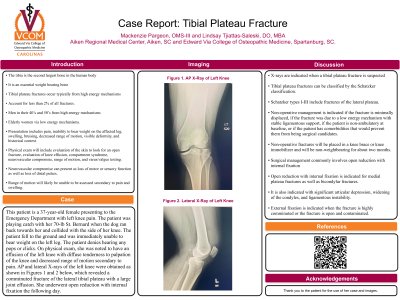Back

Clinical: General Topics
Case Report: Tibial Plateau Fracture
Friday, March 31, 2023
12:00 PM East Coast USA Time

- MP
Mackenzie Pargeon, OMS
VCOM
Spartanburg, South Carolina, United States
Presenting Author(s)
Introduction: Tibial plateau fractures are uncommon injuries accounting for only 1-2% of fractures. This case highlights a tibial plateau fracture, a rare fracture, occurring in a woman outside the typical age distribution and by an uncommon mechanism. This case demonstrates that although tibial plateau fractures are high energy mechanism injuries, they should still be considered in a patient with an injury to the knee, whether it be high energy or otherwise.
Case Study: The patient in this case presented to the Emergency Department with pain and swelling of the left knee after being run into by her 70-pound St. Bernard while playing catch. Physical exam showed effusion of the left knee with decreased range of motion. Radiographs demonstrated a comminuted fracture of the lateral tibial plateau with large joint effusion. There are a wide variety of injuries that could have occurred in this patient due to the knee's wide array of muscular, bony, and ligamentous attachments. This was a clear-cut diagnosis once radiographs were obtained. She was scheduled for an open reduction with internal fixation the following day. Surgery is the mainstay of treatment, however, there are certain circumstances in which a patient may receive conservative treatment for such a high-impact injury. In deciding management, it is important to consider the patient as a whole, their lifestyle, age, comorbidities, surgical candidacy, and other factors that affect the patient as an individual.
Discussion: Tibial plateau fractures are typically caused by high energy mechanisms in young men in their 40’s and 50’s and low energy mechanisms in elderly, osteoporotic females. This patient was a 37-year-old female who was run into by her dog and did not have any history of predisposing conditions. A review of the literature demonstrated that most patients with high energy tibial plateau fractures are caused by car accidents, and these fractures are commonly known as “bumper fractures.” Although this patient presented in the typical fashion and was treated with the common surgical management, her mechanism of injury, age, and lack of predisposing risk factors make this an unusual case. This case highlights the importance of having a broad differential and completing a thorough workup. These fractures have many different classifications and management options vary, although most are surgical. This case explores the osteopathic tenants by showing that individualized management is crucial when delivering personalized and high quality care.
Case Study: The patient in this case presented to the Emergency Department with pain and swelling of the left knee after being run into by her 70-pound St. Bernard while playing catch. Physical exam showed effusion of the left knee with decreased range of motion. Radiographs demonstrated a comminuted fracture of the lateral tibial plateau with large joint effusion. There are a wide variety of injuries that could have occurred in this patient due to the knee's wide array of muscular, bony, and ligamentous attachments. This was a clear-cut diagnosis once radiographs were obtained. She was scheduled for an open reduction with internal fixation the following day. Surgery is the mainstay of treatment, however, there are certain circumstances in which a patient may receive conservative treatment for such a high-impact injury. In deciding management, it is important to consider the patient as a whole, their lifestyle, age, comorbidities, surgical candidacy, and other factors that affect the patient as an individual.
Discussion: Tibial plateau fractures are typically caused by high energy mechanisms in young men in their 40’s and 50’s and low energy mechanisms in elderly, osteoporotic females. This patient was a 37-year-old female who was run into by her dog and did not have any history of predisposing conditions. A review of the literature demonstrated that most patients with high energy tibial plateau fractures are caused by car accidents, and these fractures are commonly known as “bumper fractures.” Although this patient presented in the typical fashion and was treated with the common surgical management, her mechanism of injury, age, and lack of predisposing risk factors make this an unusual case. This case highlights the importance of having a broad differential and completing a thorough workup. These fractures have many different classifications and management options vary, although most are surgical. This case explores the osteopathic tenants by showing that individualized management is crucial when delivering personalized and high quality care.
